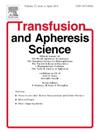Adapting the Cohn 6th cold ethanol fractionation method for small plasma pools: An innovative platform for developing hyperimmunoglobulin products against antibiotic-resistant infections in resource-limited settings
IF 1.4
4区 医学
Q4 HEMATOLOGY
引用次数: 0
Abstract
The growing challenge of antimicrobial resistance (AMR) requires innovative strategies to combat multidrug-resistant infections. Vaccination is an effective approach, often considered a potential solution, however, its application against some of the most challenging multidrug-resistant bacteria, has been unsuccessful so far. In contrast, passive immunotherapy using high-titer specific antibodies can offer immediate solutions for infections where conventional antibiotics fail. This study describes the adaptation of the Cohn 6th cold ethanol fractionation method for small plasma pools, enabling the production of high-quality intravenous immunoglobulin (IVIG) products in resource-limited settings. Using small-scale plasma batches (12 L), the modified protocol achieved a yield of 4.5 ± 0.2 g/L IgG with > 98 % purity, meeting European Pharmacopoeia requirements. Additional purification, viral safety, and filtration steps ensured sterility, low endotoxin levels, and robust viral inactivation. Safety evaluations confirmed sterility, absence of pyrogens, and stability over 24 months. This scalable methodology provides a practical platform for developing hyperimmunoglobulin products targeting AMR pathogens, particularly in resource-limited countries where large-scale fractionation infrastructure is unavailable and also not suitable. Our future efforts will focus on integrating this platform into combination therapies to enhance clinical outcomes in AMR infection management.
将Cohn第6次冷乙醇分离方法用于小型血浆池:在资源有限的环境中开发抗抗生素耐药感染的高免疫球蛋白产品的创新平台
抗菌素耐药性(AMR)的挑战日益严峻,需要创新战略来对抗耐多药感染。疫苗接种是一种有效的方法,通常被认为是一种潜在的解决方案,然而,它在一些最具挑战性的耐多药细菌上的应用迄今尚未成功。相比之下,使用高滴度特异性抗体的被动免疫疗法可以为传统抗生素无效的感染提供即时解决方案。本研究描述了Cohn第6次冷乙醇分离方法对小型血浆池的适应性,使在资源有限的环境下生产高质量的静脉注射免疫球蛋白(IVIG)产品成为可能。在小规模血浆批次(12 L)中,改进方案的IgG产率为4.5 ± 0.2 g/L,纯度为 98 %,符合欧洲药典要求。额外的纯化、病毒安全性和过滤步骤确保了无菌性、低内毒素水平和强大的病毒灭活。安全性评估证实无菌,无热原,稳定性超过24个月。这种可扩展的方法为开发针对抗菌素耐药性病原体的超免疫球蛋白产品提供了一个实用平台,特别是在资源有限的国家,那里没有大规模的分离基础设施,也不适合。我们未来的努力将集中于将该平台整合到联合治疗中,以提高AMR感染管理的临床结果。
本文章由计算机程序翻译,如有差异,请以英文原文为准。
求助全文
约1分钟内获得全文
求助全文
来源期刊
CiteScore
3.60
自引率
5.30%
发文量
181
审稿时长
42 days
期刊介绍:
Transfusion and Apheresis Science brings comprehensive and up-to-date information to physicians and health care professionals involved in the rapidly changing fields of transfusion medicine, hemostasis and apheresis. The journal presents original articles relating to scientific and clinical studies in the areas of immunohematology, transfusion practice, bleeding and thrombotic disorders and both therapeutic and donor apheresis including hematopoietic stem cells. Topics covered include the collection and processing of blood, compatibility testing and guidelines for the use of blood products, as well as screening for and transmission of blood-borne diseases. All areas of apheresis - therapeutic and collection - are also addressed. We would like to specifically encourage allied health professionals in this area to submit manuscripts that relate to improved patient and donor care, technical aspects and educational issues.
Transfusion and Apheresis Science features a "Theme" section which includes, in each issue, a group of papers designed to review a specific topic of current importance in transfusion and hemostasis for the discussion of topical issues specific to apheresis and focuses on the operators'' viewpoint. Another section is "What''s Happening" which provides informal reporting of activities in the field. In addition, brief case reports and Letters to the Editor, as well as reviews of meetings and events of general interest, and a listing of recent patents make the journal a complete source of information for practitioners of transfusion, hemostasis and apheresis science. Immediate dissemination of important information is ensured by the commitment of Transfusion and Apheresis Science to rapid publication of both symposia and submitted papers.

 求助内容:
求助内容: 应助结果提醒方式:
应助结果提醒方式:


